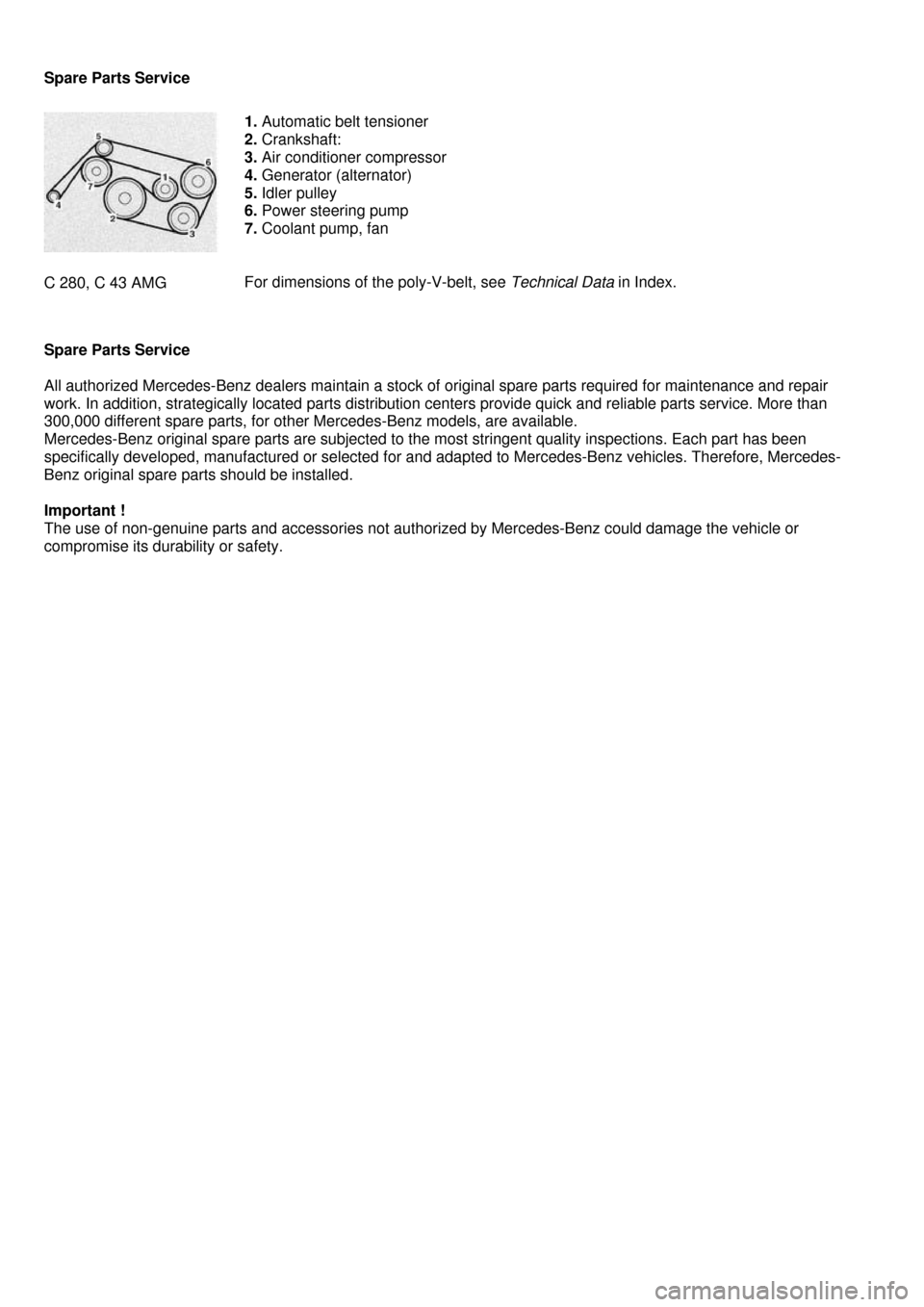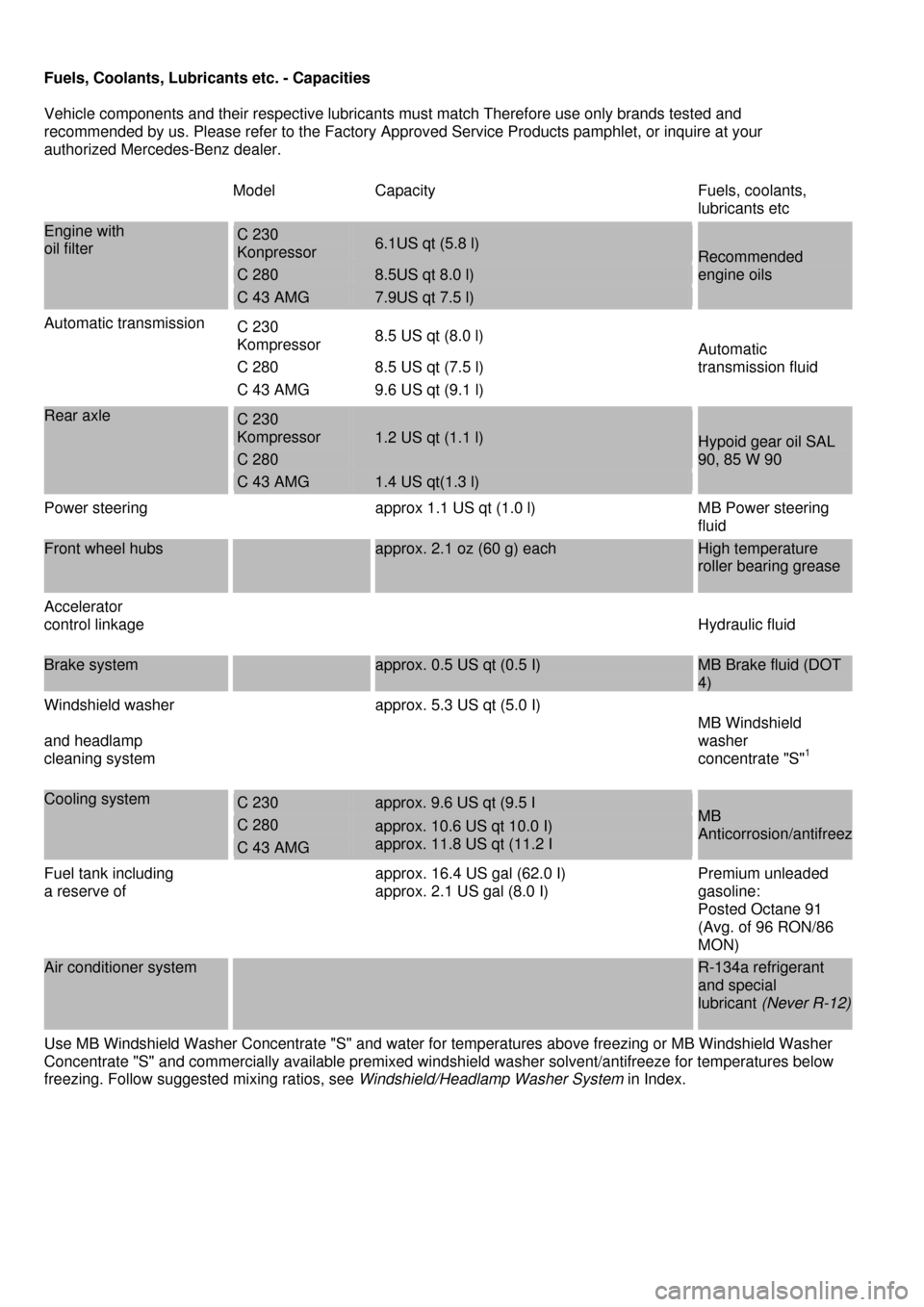Service MERCEDES-BENZ C-Class 2000 W202 User Guide
[x] Cancel search | Manufacturer: MERCEDES-BENZ, Model Year: 2000, Model line: C-Class, Model: MERCEDES-BENZ C-Class 2000 W202Pages: 130, PDF Size: 2.43 MB
Page 83 of 130

Emission Control
Certain systems of the engine serve to keep the toxic components of the exhaust gases within permissible limits
required by law. These systems, of course, will function properly only when maintained strictly according to factory
specifications. Any adjustments on the engine should, ther efore, be carried out only by qualified Mercedes-Benz
authorized dealer technicians. Engine adjustments should not be altered in any way. Moreover, the specified service
jobs must be carried out regularly according to Mercedes -Benz servicing requirements. For details refer to the
Service Booklet.
Warning !
Inhalation of exhaust gas is hazardous to your health. All exhaust gas contains carbon monoxide, and
inhaling it can cause unconsciousness and lead to death.
Do not run the engine in confined areas (such as a garage) which are not properly ventilated.
If you think that exhaust gas fumes are entering the vehicle while driving, have the cause determined and
corrected immediately. If you must drive under these conditions, drive only with at least one window fully
open.
On-Board Diagnostic System
The Sequential Multiport Fuel Injection (SFI) control module monitors emission control components that either provide
input signals to or receive output sign als from the control module. Malfunctions resulting from interruptions or failure
of any of these components are indica ted by the "CHECK ENGINE" malfunction indicator lamp in the instrument
cluster and are simultaneously stored in the SFI control module. If the "CHECK ENGINE" malfunction indicator lamp
comes on, have the system checked at your authorized Mercedes-Benz dealer as soon as possible. With some
exceptions the control module switches off the "CHECK ENGINE" indicator lamp if the condition, causing the lamp to
come on, no longer exists during three consecutive cycles. An on-board diagnostic connector is located in the
passenger compartment near to the parking brake pedal, allowi ng the accurate identification of system malfunctions
through the readout of diagnostic trouble codes.
Page 84 of 130

Winter Driving
Have your car winterized at your authorized Mercedes-Benz dealer before the onset of winter.
• Change the engine oil if the engine contains an oil which is not approved for winter operation.
For viscosity (SAE/CCMC class) and filling quantity, see Capacities: Fuels, Coolants,
Lubricants etc. in Index.
• Check engine coolant anticorr osion/antifreeze concentration.
• Additive for the windshield washer and headl amp cleaning system: Add MB Concentrate "S"
to a premixed windshield washer solvent/ant ifreeze which is formulated for below freezing
temperatures (see Index).
• Test battery: Battery capacity drops with dec reasing ambient temperature. A well charged
battery helps to ensure that the engine can be started, even at low ambient temperatures.
• Tires: We recommend M+S rated radial-ply tires on all four wheels for the winter season.
Observe permissible maximum speed for M+S rated radial-ply tires and the legal speed limit.
Note:
In winter operation, the maximum effectiveness of the Antilock Brake System (ABS), Acceleration Slip Regulation
(ASR) or the Electronic Stab ility Program (ESP) can only be achieved with M+S rated radial-ply tires and/or snow
chains recommended by Mercedes-Benz. Snow chains maximize performance.
Snow Chains
Use only snow chains that are tested and recommended by Mercedes-Benz. Your authorized Mercedes-Benz
dealer will be glad to advise you on this subject. Ch ains should only be used on the rear wheels.
Follow the manufacturer's mounting instructions. Snow ch ains should only be driven on snow covered roads at
speeds not to exceed 30 mph (50 km/h). Remove chains as soon as possible when driving on roads without snow.
For tips on driving on slippery winter roads, refer to In dex. Vehicles with Acceleration Slip Regulation (ASR) or
Electronic Stability Program (ESP): When driving with snow chains, press the ASR or ESP control switch, refer to
Index.
Model C 43 AMG
Important !
Use of snow chains is permissible only on winter tire size 215/45 R 17 H M+S. Refer to "Rims - Tires" in section
"Technical Data" (see Index).
Travelling Abroad
Abroad, there is a widely-spread Mercedes-Benz service network at your disposal. If you plan to travel into areas
which are not listed in the index of your dealer directory, you should request pertinent information from your
authorized Mercedes-Benz dealer.
Page 92 of 130

Wheels
Replace rims or tires with the same designation, manufacturer and type as shown on the original part. See your
authorized Mercedes-Benz dealer for further information. See your authorized Mercedes-Benz dealer for information
on tested and recommended rims and tires for summer and wi nter operation. They can also offer advice concerning
tire service and purchase.
Tire Replacement
Front tires should be replaced in sets. Rims and tires must be of the correct size and type. For dimensions, see
"Technical Data". We recommend that you break in new ti res for approx. 60 miles (100 km) at moderate speed. It is
imperative that the wheel mounting bolts be fastened to a tightening torque of 80 ft.lb. (110 Nm) whenever wheels are
mounted. For rim and tire specifications, refer to "Technical Data".
Warning !
Worn, old tires can cause accidents. If the tire tread is badly worn, or if the tires have sustained damage, replace
them. When replacing rirns, use only genuine Mercedes-Benz w heel bolts specified for the particular rim type. Failure
to do so can result in the bolts loosening and possibly an accident.
Rotating Wheels
Rotation of wheels with summer tires does not apply to m odel C 43 AMG. The wheels can be rotated according to the
degree of tire wear while retaining the same direction of travel. Rotating, however, should be carried out at the
scheduled service intervals, before the characteristic tire wear pattern (shoulder wear on front wheels and tread
center wear on rear wheels) becomes visible, as otherwise the driving properties deteriorate.
Important !
Unidirectional tires must always be mounted with arrow on tire sidewall pointing in direction of vehicle forward
movement.
Notes:
Thoroughly clean the inner side of the wheels any time you rotate the wheels or wash the vehicle underside. The use
of retread tires is not recommended. Retread tires may adversely affect the handling charac teristics and safety of the
vehicle. Dented or bent rims can caus e tire pressure loss and damage to the tire beads. For this reason, check rims
for damage at regular intervals. The rim flanges must be checked for wear before a tire is mounted. Remove burrs, if
any. Check and ensure proper tire inflation pressure after rotating the wheels. For Tire Inflation Pressure refer to
Index.
Spare Wheel (except C 43 AMG)
Important !
The spare wheel rim is mounted with a full size tire of the same type as on the vehicle, and is fully functional.
However, that spare wheel rim is weight optimized an d has a limited service life of 12 000 miles (20 000 km) use
before a standard wheel rim must replace it. In the case of a flat tire, you may temporarily use the spare wheel. Do
not operate vehicle with more than one spare wheel mounted.
Unidirectional tires must always be mounted with arrow on tire sidewall pointing in direction of vehicle forward
movement. If the arrow on tire side wall does not point in direction of vehicle forward movement when using the spare
wheel, observe the following restrictions:
• Drive to the nearest tire repair facility as soon as possible.
For rim and tire specifications, refer to "Technical Data".
Warning !
The spare wheel rim is for temporary use only. Use for over a total of 12 000 miles
(20 000 km) may cause wheel rim failure leading to an accident and possible injuries.
Page 101 of 130

Battery
Warning !
Failure to follow these instructions can result in severe injury or death. Never lean over batteries while
connecting, you might get injured. Battery fluid contains sulfuric acid. Do not allow this fluid to come in
contact with eyes, skin or clothing. In case it does, immediately flush affected area with water and seek
medical help if necessary. A battery will also produ ce hydrogen gas, which is flammable and explosive.
Keep flames or sparks away from battery, avoid im proper connection of jumper cables, smoking etc..
Important !
Battery maintenance information:
The battery is located in the trunk under the trunk floor. The fluid level must be checked at every A and B service.
Always insure that the fluid level is at the specified maximum level and that only distilled water is used. Failure to
maintain proper fluid level may result in cell deterioration and possible battery rupture. The service life of the battery is
dependent on its condition of charge. The battery should alwa ys be kept sufficiently charged, in order to last an
optimum length of time.
Therefore, we strongly recommend that you have the battery charge checked frequently, and corrected if
necessary, especially if you use the vehicle less than approximately 200 miles (300 km) per month, mostly for
short distance trips, or if it is not used for long periods of time.
Only charge a battery with a battery charger after the battery has been disconnected from the vehicle electrical circuit.
Always disconnect the battery negative lead first and connect last. When removing and connecting the battery,
always make sure that all electrical consumers are off and the electronic key is in steering lock position 0. The battery
and its vent tube must always be securely installed when the car is in operation. While the engine is running the
battery terminal clamps must not be loosened or detached, otherwise the generator and other electronic components
would be damaged.
Note:
After reconnecting the battery also resynchronize the Express feature of the power windows, the
sliding/pop-up roof, and the Electronic Stability Program (ESP) (see Power seats, front, Head
restraints, Power windows, Sliding/pop-up roof, and Electronic stability program in Index).
Battery Recycling
Batteries contain materials that can harm the environment with improper disposal. Large 12 Volt storage batteries
contain lead. Recycling of batteries is the preferred method of disposal. Many states require sellers of batteries to
accept old batteries for recycling.
Page 115 of 130

Spare Parts Service
C 280, C 43 AMG
1. Automatic belt tensioner
2. Crankshaft:
3. Air conditioner compressor
4. Generator (alternator)
5. Idler pulley
6. Power steering pump
7. Coolant pump, fan
For dimensions of the poly-V-belt, see Technical Data in Index.
Spare Parts Service
All authorized Mercedes-Benz dealers maintain a stock of original spare parts required for maintenance and repair
work. In addition, strategically located parts distribution centers provide quick and reliable parts service. More than
300,000 different spare parts, for other Mercedes-Benz models, are available.
Mercedes-Benz original spare parts are subjected to the most stringent quality inspections. Each part has been
specifically developed, manufactured or selected for and adapted to Mercedes-Benz vehicles. Therefore, Mercedes-
Benz original spare parts should be installed.
Important !
The use of non-genuine parts and accessories not authorized by Mercedes-Benz could damage the vehicle or
compromise its durability or safety.
Page 117 of 130

Warranty Coverage
Your car is covered under the terms of the "warranties" printed in the Owner's Service and
Warranty Information booklet and your authoriz ed Mercedes-Benz dealer will exchange or
repair any defective parts in accordance wi th the terms of the following warranties:
1. New vehicle limited warranty
2. Emission systems warranty
3. Emission performance warranty
4. California and Massachusetts emission control systems warranty.
Loss of Owner's Service and Warranty Information Booklet
Should you lose your Owner's Service and Warr anty Information booklet, have your authorized
Mercedes-Benz dealer arrange for a replacement. It will be mailed to you.
Page 122 of 130

Fuels, Coolants, Lubricants etc. - Capacities
Vehicle components and their respective lubricants must match Therefore use only brands tested and
recommended by us. Please refer to the Factory Approv ed Service Products pamphlet, or inquire at your
authorized Mercedes-Benz dealer.
Model Capacity Fuels, coolants,
lubricants etc
Engine with
oil filter C 230
Konpressor 6.1US qt (5.8 l)
C 280 8.5US qt 8.0 l)
C 43 AMG 7.9US qt 7.5 l)
Recommended
engine oils
Automatic transmission C 230
Kompressor 8.5 US qt (8.0 l)
C 280 8.5 US qt (7.5 l)
C 43 AMG 9.6 US qt (9.1 l)
Automatic
transmission fluid
Rear axle C 230
Kompressor
C 280
1.2 US qt (1.1 l)
C 43 AMG 1.4 US qt(1.3 l)
Hypoid gear oil SAL
90, 85 W 90
Power steering approx 1.1 US qt (1.0 l) MB Power steering
fluid
Front wheel hubs
approx. 2.1 oz (60 g) each High temperature
roller bearing grease
Accelerator
control linkage
Hydraulic fluid
Brake system approx. 0.5 US qt (0.5 I) MB Brake fluid (DOT
4)
Windshield washer
and headlamp
cleaning system
approx. 5.3 US qt (5.0 I)
MB Windshield
washer
concentrate "S"
1
Cooling system C 230 approx. 9.6 US qt (9.5 I
C 280
C 43 AMG
approx. 10.6 US qt 10.0 I)
approx. 11.8 US qt (11.2 I
MB
Anticorrosion/antifreez
Fuel tank including
a reserve of
approx. 16.4 US gal (62.0 I)
approx. 2.1 US gal (8.0 I) Premium unleaded
gasoline:
Posted Octane 91
(Avg. of 96 RON/86
MON)
Air conditioner system
R-134a refrigerant
and special
lubricant (Never R-12)
Use MB Windshield Washer Concentrate "S" and water for temperatures above freezing or MB Windshield Washer
Concentrate "S" and commercially available premixed windsh ield washer solvent/antifreeze for temperatures below
freezing. Follow suggested mixing ratios, see Windshield/Headlamp Washer System in Index.
Page 123 of 130

Engine Oils
Engine oils are specifically tested for their suitability in our engines. Therefore, use only engine oils
recommended by Mercedes-Benz. Information on recommended brands is available at your
authorized Mercedes-Benz dealer. Please follow service Booklet recommendations for scheduled oil
changes. Failure to do so could result in engine damage not covered by the Mercedes-Benz Limited
Warranty.
Engine Oil Additives
Do not blend oil additives with engine oil. They may be harmful to the engine operation.
Damage or malfunctions resulting from blending oil additives are not covered by the
Mercedes-Benz Limited Warranty.
Air Conditioner Refrigerant
R-134a (HFC) refrigerant and special PAG lubricat ing oil is used in the air conditioner system.
Never use R-12 (CFC) or mineral ba sed lubricating oil, otherwise damage to the system will occur.
Brake Fluid
During vehicle operation, the boiling point of the brake fluid is continuously reduced through the
absorption of moisture from the atmosphere. Under extremely hard operating conditions, this
moisture content can lead to the formation of bubbl es in the system thus reducing the system's
efficiency.
The brake fluid must therefore be replaced every two years, pr eferably in the spring. It is
recommended to use only brake fluid approved by Mercedes- Benz. Your authorized Mercedes-
Benz dealer will provide you with additional information.
Page 125 of 130

Coolants
The engine coolant is a mixture of water and anticorrosion/antifreeze, which provides:
• corrosion protection,
• freeze protection,
• boiling protection (by increasing the boiling point).
The cooling system was filled at the factory with a coolant providing freeze protection to approx. -22°F
(-30°C) and corrosion protection. The coolant solution must be used year round to provide the
necessary corrosion protection and increase in the boil-over protection. You should have it replaced
every 3 years. To provide the important corrosion protection, the solution must be at least 45%
anticorrosion/antifreeze (equals a freeze protection to approx. -22°F [-30°C]). If you use a solution
that is more than 55% anticorrosion/antifreeze (freeze protection to approx. -49°F [-45°C]), the engine
temperature will increase due to the lower heat transfer capability of the solution. Therefore, do not
use more than this amount of anticorrosion/antifreeze. If the coolant level is low, water and MB
anticorrosion/antifreeze should be used to bring it up to the proper level (have cooling system
checked for signs of leakage). The water in the cooling system must meet minimum requirements,
which are usually satisfied by normal drinking water. If you are not sure about the water quality,
consult your authorized Mercedes-Benz dealer.
Anticorrosion/antifreeze
Your vehicle contains a number of aluminum parts. The use of aluminum components in motor
vehicle engines necessitates that anticorrosion/antifreeze coolant used in such engines be specifically
formulated to protect the aluminum parts. (Failure to use such anticorrosion/antifreeze coolant will
result in a significantly shortened service life.)
Therefore the following product is strongly recommended for use in your car: Mercedes-Benz
Anticorrosion/Antifreeze Agent. Before the start of the winter season (or once a year in the hot
southern regions), you should have the anticorrosion/antifreeze concentration checked. The coolant is
also regularly checked each time you bring your vehicle to your authorized Mercedes-Benz dealer for
service.
Model Approx.freeze Protection
-35°F
(~37°C)
-49°F
(-45°C)
C 230 Kompressor 5.0 US qt
(4.75 I)
5.5 US qt
(5.25 I)
C 280 5.3 US qt
(5.0 I)
5.8 US qt
(5.5 I)
C 43 AMG 5.9US qt
(5.6 I)
6.6 US qt
(6.2 I)
Page 126 of 130

Consumer Information
This has been prepared as required of all manufacturers of passenger cars under Title 49, Code of U.S. Federal
Regulations, Part 575 pursuant to the "National Traffic and Motor Vehicle Safety Act of 1966".
Uniform Tire Quality Grading
Refer to the tire sidewall for the specific tire grades for t he tires with which this vehicle is equipped. All passenger car
tires must conform to federal safety requirements in addition to these grades.
Treadwear
The treadwear grade is a comparative rating based on t he wear rate of the tire when tested under controlled
conditions on a specified government test course. For ex ample, a tire graded 150 would wear one and one-half (11/2)
times as well on the government course as a tire grad ed 100. The relative performance of tires depends upon the
actual conditions of their use, however, and may depart signi ficantly from the norm due to variations in driving habits,
service practices and differences in road characteristics and climate.
Traction
The traction grades, from highest to lowest, are AA, A, B, and C, Those grade represent the tire's ability to stop on
wet pavement as measured under controlled conditions on specified government test surfaces of asphalt and
concrete. A tire marked "C" ma y have poor traction performance.
Warning !
The traction grade assigned to this tire is based on straight-ahead braking traction tests and does not
include cornering, hydroplaning or peak traction characteristics.
Temperature
The temperature grades are A (the highest), B, and C, representing the tire's resistance to the generation of heat and
its ability to dissipate heat when tested under controlled conditions on a specified indoor laboratory test wheel.
Sustained high temperature can cause the material of the tire to degenerate and reduce tire life, and excessive
temperature can lead to sudden tire failure. The grade C co rresponds to a level of performance which all passenger
car tires must meet under the Federal Motor Vehicle Safety Standard No.109. Grades B and A represent higher
levels of performance on the laboratory test wheel than the minimum required by law.
Warning !
The temperature grade for this tire is established for a tire that is properly inflated and not overloaded.
Excessive speed, underinflation, or excessive loading, either separately or in combination, can cause
excessive heat build up and possible tire failure.